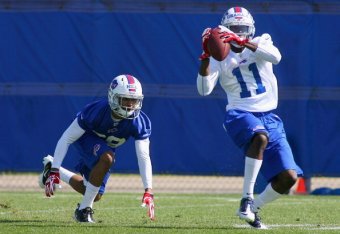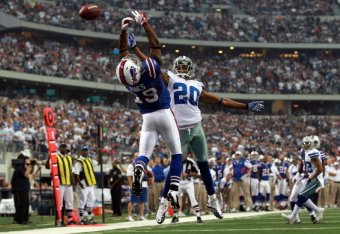Jordan Rogowski - The year was 2002.
Eric Moulds lined up on one side of then Buffalo Bills quarterback Drew Bledsoe, Peerless Price on the other. The prolific tandem eviscerated opposing secondaries on a week-by-week basis, and 4,400 Bledsoe yards later, the Bills thought they had a passing game that would bring them back to the perennial playoff berths of the golden '90s.
Of course, in Buffalo, nothing ever seems to go by plan.
Price bolted for Atlanta the following year and waded in mediocrity until finishing his career with the Bills in 2007, a hollow shell of the promise that once was. Moulds had some serviceable seasons in the years that followed, but like Price, he could never regain that 2002 form.
Ever since, the Bills have looked for a true No. 2 receiver to flank whomever topped the depth chart. Moulds and Lee Evans have come and gone, and now it's seventh-round standout Stevie Johnson drawing all the double-teams and elite corners while teams nary need to game-plan for anyone lining up outside the opposite hash.
With a young, gifted crop of hopefuls amassing at St. John Fisher College for training camp this week, Chan Gailey and his staff are hoping to find what's been missing for the past 10 years. Third-year pro Donald Jones was announced the starter for camp this week but if Gailey's words are any indication, it could not be a more wide-open competition:
 Rick Stewart/Getty Images
Rick Stewart/Getty Images
Now, let's take a look at the hopefuls.
Marcus Easley:
Beset by season-ending ailments in back-to-back training camps, the former Connecticut University wideout is looking to make up for lost time. At 6'3", 221 lbs, the organization has been enamored with his size and athleticism since making him a fourth-round selection in 2010, and he's exactly the kind of player that could thrive opposite Stevie Johnson.
Easley has a terrific pair of hands, and his big frame would make him the biggest threat where all other Bills have struggled to make an impact—in the red zone. His body and skill set are tailor-made for fade routes, and he's also capable of going up and getting balls in traffic on the sidelines and across the middle of the field.
Though he lacks the top-end speed to stretch opposing secondaries, his size alone would create mismatches for Fitzpatrick and co. to capitalize on. If Easley could be a Dwayne Bowe-type wideout for the Bills, it would go a long way in keeping their offense on the field this season.
T.J. Graham:
 Ronald Martinez/Getty Images
An extremely intriguing prospect out of North Carolina State,
Graham has the elite straight-line speed that the Bills have been
without since Lee Evans' better years. NFL Films' Greg Cosell likened Graham to Pittsburgh Steelers burner Mike Wallace, and called him the most vertically explosive wide receiver in the 2012 draft.
Ronald Martinez/Getty Images
An extremely intriguing prospect out of North Carolina State,
Graham has the elite straight-line speed that the Bills have been
without since Lee Evans' better years. NFL Films' Greg Cosell likened Graham to Pittsburgh Steelers burner Mike Wallace, and called him the most vertically explosive wide receiver in the 2012 draft.
He's not without his limitations, though.
Graham was not called upon to run much of a route tree at NC State; he was used mostly on streak and seam routes, as well as bubble screens. With the kind of four and five-wideout sets that Buffalo loves to run, those bubble screens could be highly effective in getting Graham in space. However, there are questions about whether or not quarterback Ryan Fitzpatrick possesses the touch on his deep ball to utilize the rookie's straight-line speed.
His small frame is also worrisome; at 6'0" and just 180 lbs, concern exists about whether or not he'll be able to go across the middle and make the tough catches. Wide receivers his size don't typically make their home between the hashes, and he has been somewhat fumble-prone, so that limits how Gailey will actually be able to use him.
Donald Jones:
The incumbent No. 2 man from much of last year's campaign, Donald Jones brings some solid qualities to the table.
Jones is a very adept route-runner, and very much benefits from the amount of three and four-WR sets the Bills operate. With plenty of open space with which to work, Jones can carve defensive backs on quick hitches just as easily as he can use his deceptive speed to take a slant or a screen for additional yardage.
On his touchdown from Buffalo's 2010 meeting with the Cincinnati Bengals, you can see Jones turn a jailbreak screen that should have been stopped for no more than eight or nine yards into a 32-yard score.
Reminiscent of Larry Fitzgerald's safety-splitting touchdown from Super Bowl XLIII, Jones kicks into a second gear to blow past would-be tacklers into the end zone.
There's no doubt that the Youngstown State export can help the offense, but no one particular aspect of his game really jumps out. Though his size isn't a detriment—Jones measures in at 6'0", 208 lbs—he has neither the elite speed to pull back the safeties nor the size and catching radius to command a double-team.
With training camp just beginning and no preseason games yet played, there's plenty of jostling for position left to go between Buffalo's No. 2 wide receiver hopefuls, but there's little doubt that a game-changer opposite Stevie Johnson would get Buffalo that much closer to its first playoff game since 1999.
Eric Moulds lined up on one side of then Buffalo Bills quarterback Drew Bledsoe, Peerless Price on the other. The prolific tandem eviscerated opposing secondaries on a week-by-week basis, and 4,400 Bledsoe yards later, the Bills thought they had a passing game that would bring them back to the perennial playoff berths of the golden '90s.
Of course, in Buffalo, nothing ever seems to go by plan.
Price bolted for Atlanta the following year and waded in mediocrity until finishing his career with the Bills in 2007, a hollow shell of the promise that once was. Moulds had some serviceable seasons in the years that followed, but like Price, he could never regain that 2002 form.
Ever since, the Bills have looked for a true No. 2 receiver to flank whomever topped the depth chart. Moulds and Lee Evans have come and gone, and now it's seventh-round standout Stevie Johnson drawing all the double-teams and elite corners while teams nary need to game-plan for anyone lining up outside the opposite hash.
With a young, gifted crop of hopefuls amassing at St. John Fisher College for training camp this week, Chan Gailey and his staff are hoping to find what's been missing for the past 10 years. Third-year pro Donald Jones was announced the starter for camp this week but if Gailey's words are any indication, it could not be a more wide-open competition:
“Donald will start there but, still, we're looking at everybody,” Gailey said. “We've not ruled anybody out at this point at that spot. You've got to have somebody that walks out there the first day and you all will write about it and talk about it, but we're going to move people around at different times during camp to try to get equal reps at left tackle, try to get equal reps at quarterback. Just because a guy starts the first day doesn't mean anything. There's some spots that we understand, there's competition and we're going to try to make sure that we make it as equal as possible going into the season.”
 Rick Stewart/Getty Images
Rick Stewart/Getty Images
Now, let's take a look at the hopefuls.
Marcus Easley:
Beset by season-ending ailments in back-to-back training camps, the former Connecticut University wideout is looking to make up for lost time. At 6'3", 221 lbs, the organization has been enamored with his size and athleticism since making him a fourth-round selection in 2010, and he's exactly the kind of player that could thrive opposite Stevie Johnson.
Easley has a terrific pair of hands, and his big frame would make him the biggest threat where all other Bills have struggled to make an impact—in the red zone. His body and skill set are tailor-made for fade routes, and he's also capable of going up and getting balls in traffic on the sidelines and across the middle of the field.
Though he lacks the top-end speed to stretch opposing secondaries, his size alone would create mismatches for Fitzpatrick and co. to capitalize on. If Easley could be a Dwayne Bowe-type wideout for the Bills, it would go a long way in keeping their offense on the field this season.
T.J. Graham:
 Ronald Martinez/Getty Images
Ronald Martinez/Getty Images
He's not without his limitations, though.
Graham was not called upon to run much of a route tree at NC State; he was used mostly on streak and seam routes, as well as bubble screens. With the kind of four and five-wideout sets that Buffalo loves to run, those bubble screens could be highly effective in getting Graham in space. However, there are questions about whether or not quarterback Ryan Fitzpatrick possesses the touch on his deep ball to utilize the rookie's straight-line speed.
His small frame is also worrisome; at 6'0" and just 180 lbs, concern exists about whether or not he'll be able to go across the middle and make the tough catches. Wide receivers his size don't typically make their home between the hashes, and he has been somewhat fumble-prone, so that limits how Gailey will actually be able to use him.
Donald Jones:
The incumbent No. 2 man from much of last year's campaign, Donald Jones brings some solid qualities to the table.
Jones is a very adept route-runner, and very much benefits from the amount of three and four-WR sets the Bills operate. With plenty of open space with which to work, Jones can carve defensive backs on quick hitches just as easily as he can use his deceptive speed to take a slant or a screen for additional yardage.
On his touchdown from Buffalo's 2010 meeting with the Cincinnati Bengals, you can see Jones turn a jailbreak screen that should have been stopped for no more than eight or nine yards into a 32-yard score.
Reminiscent of Larry Fitzgerald's safety-splitting touchdown from Super Bowl XLIII, Jones kicks into a second gear to blow past would-be tacklers into the end zone.
There's no doubt that the Youngstown State export can help the offense, but no one particular aspect of his game really jumps out. Though his size isn't a detriment—Jones measures in at 6'0", 208 lbs—he has neither the elite speed to pull back the safeties nor the size and catching radius to command a double-team.
With training camp just beginning and no preseason games yet played, there's plenty of jostling for position left to go between Buffalo's No. 2 wide receiver hopefuls, but there's little doubt that a game-changer opposite Stevie Johnson would get Buffalo that much closer to its first playoff game since 1999.

No comments:
Post a Comment